Nyheter
Detrimental Allegations and a Regulatory Win: What Happened in Crypto This Week?
Publicerad
1 år sedanden
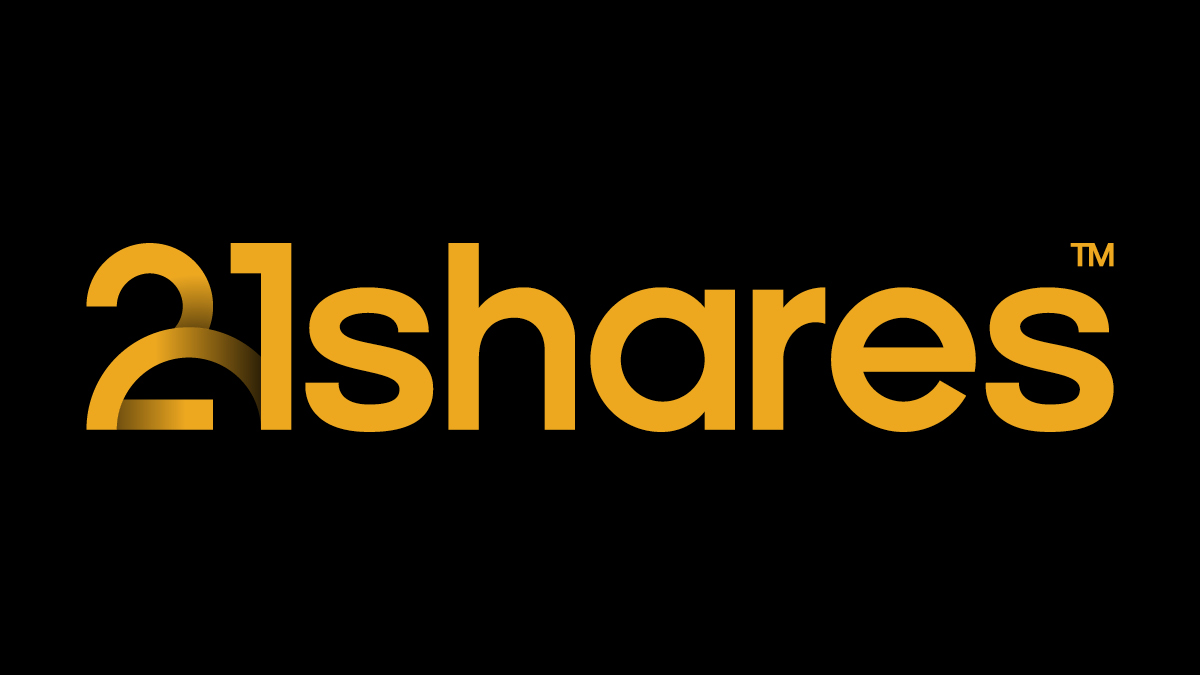
The U.S. government ran a $2.02 trillion deficit for the fiscal year through September, almost double last year’s. The Nasdaq Composite and S&P 500 are down by almost 3% over the past week. On the other hand, the top 15 cryptoassets by market cap have performed positively from last week. Bitcoin and Ethereum increased by nearly 16% and 10% over the past week, respectively. The biggest positive outliers of this week were Stacks, surging by 34%, Solana by 32.36%, and Aave, 30.37%.
Figure 1: Weekly Price and TVL Developments of Cryptoassets in Major Sectors
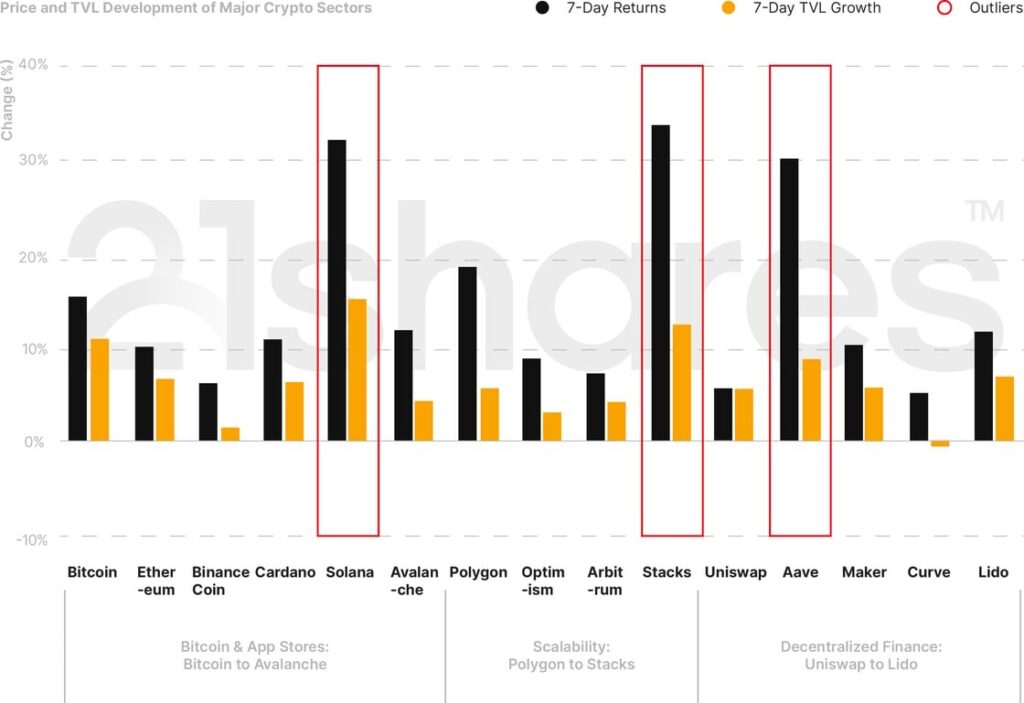
Source: 21Shares, CoinGecko, DeFi Llama. Close data as of October 23, 2023.
6 Things to Remember in Markets this Week
• Higher Yields Leave U.S. Banks with Massive Unrealized Losses
Bank of America’s unrealized losses on securities rose to $131.6B after the 10-year U.S. Treasury yield reached 4.93%, a figure not seen since 2007, before the Global Financial Crisis. Higher yields force bond prices to fall, ultimately leading to massive unrealized losses for prominent financial institutions betting on the bond market. On Thursday, Fed Chair Jerome Powell said that soaring bond yields could help the Fed slow the economy, further cooling inflation and possibly leading to the end of rate hikes. In this regard, a peak in real rates would be positive for risk assets. Many investors consider U.S. Treasuries the best proxy of a “risk-free” rate and thus view them as an opportunity cost – lower expected yields lead to lower discount rates, which result in a higher value for risky assets like stocks and crypto.
Figure 2: 10Y U.S Treasury Yield (2007-2023)
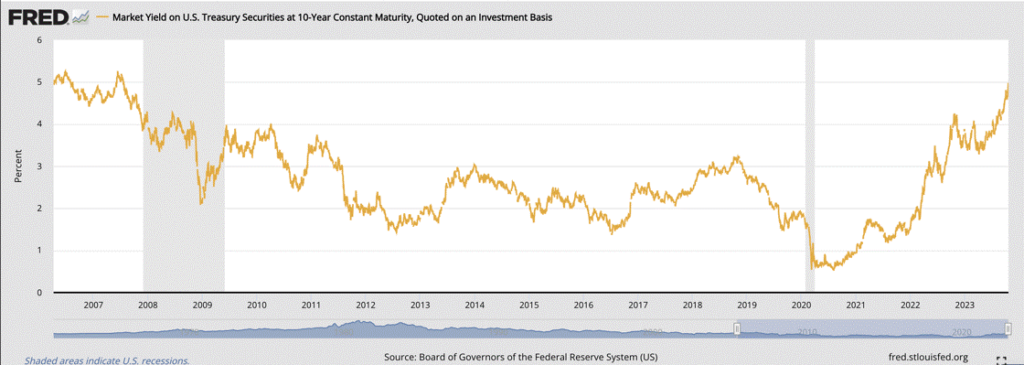
Source: St. Louis Fed
• Detrimental Allegations Against Gemini, Genesis, DCG, and Two Executives
New York Attorney General Letitia James filed a complaint against Gemini Trust and Genesis Capital, who both operated the troubled Gemini Earn product, on which the charges are based. The complaint is also against Digital Currency Group (DCG), owner and operator of Genesis, along with the latter’s CEO, Michael Moro, and DCG’s CEO, Barry Silbert, who are all facing criminal charges. The criminal charges include defrauding Gemini Earn investors, concealing a billion dollars in losses, and allegedly lying about their then-deteriorating financial condition. The key takeaway from the complaint was that Gemini lied to its Earn investors while allegedly siphoning millions of dollars taken from investor assets and handing them over to Genesis Capital, even after Earn was suspended. On June 13, 2022, one of Genesis’ largest borrowers, Three Arrows Capital, defaulted on billions of dollars in loans. The resulting losses created a “structural hole” at Genesis Capital that impaired its ability to repay its open-term liabilities—including to Earn investors.
The complaint documented social media threads, later in June and September 2022, that falsely described the financial condition of Genesis Capital, which filed for bankruptcy last January. For its part, DCG told the Block that they intend to fight the claims against Silbert and its employees. The allegations in this lawsuit can further discourage users from leaving their assets on centralized exchanges or not engaging with them altogether. As shown in the figure below, Bitcoin and Ethereum’s balance on centralized exchanges is in steady and sharp decline, respectively.
Figure 3: Bitcoin and Ethereum’s Balance on Exchanges
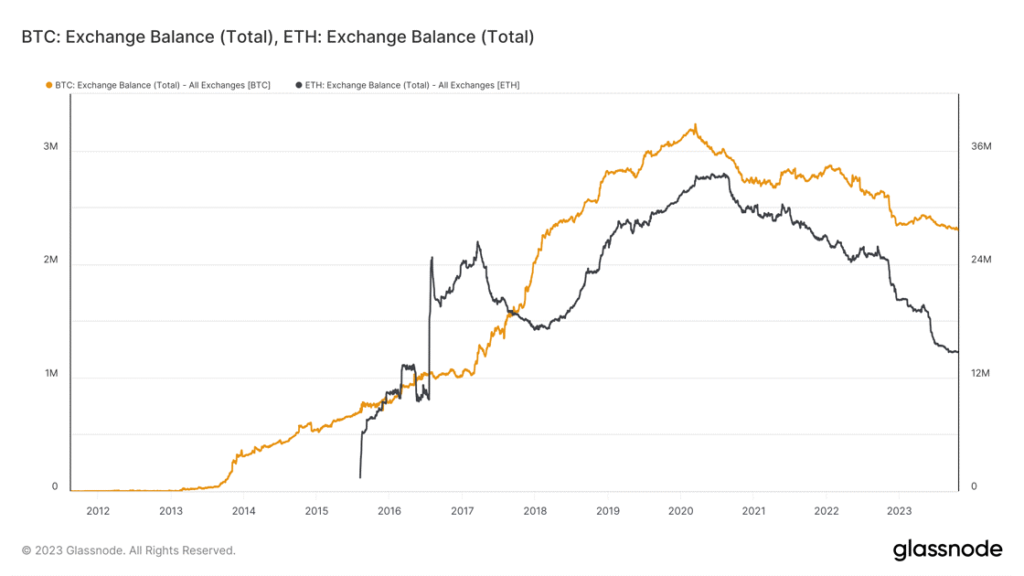
Source: Glassnode
• New Win for Ripple Boosts XRP Returns
The Securities and Exchanges Commission (SEC) dropped lawsuits against two executives at Ripple Labs, claiming that Chief Executive Brad Garlinghouse and co-founder Chris Larsen aided and abetted sales of Ripple’s native token XRP which a judge had found amounted to unregistered sales of securities only in the case of institutional sales. However, the programmatic sales of XRP, those sold on exchanges and distributed to employees, did not constitute a securities offering, in the judge’s opinion. XRP was up by 7.6% in the 24 hours following the news and 10% over the past week. The SEC and Ripple Labs have until November 9, as requested by the former, to reach a resolution regarding the institutional sales of the token.
• Stablecoins on Bitcoin
Lightning Labs is bringing stablecoins and real-world assets (RWA) to Bitcoin via Taproot Assets upgrade, aiming to make Bitcoin “the global routing network for the internet of money.” With this release, developers can issue financial assets on-chain in a scalable manner, providing a feature-complete developer experience for issuing, managing, and exploring stablecoins or other assets on the Bitcoin blockchain. With this upgrade, Bitcoin would be competing with Ethereum, the largest settlement layer for stablecoins. Over 56% of the $124B stablecoin market value is built on Ethereum and its compatible scaling solutions. However, with its first-mover advantage, Bitcoin has had historically more active users on the network in comparison to Ethereum’s.
It is worth noting that the Lightning Network has experienced a new class of attacks on Bitcoin’s mempool, which signaled alarms in the developer community building on the network. The fix has to be done on the base layer, specifically adding a memory-intensive history of all-seen transactions or some consensus upgrade, according to a suggestion made by Antoine Riard, a Bitcoin core developer who allegedly stepped back from the Lightning Network due to this “hard dilemma,” and will continue to shift his focus on Bitcoin core development.
Figure 4: Comparison between Active Addresses on Bitcoin and Ethereum’s Networks
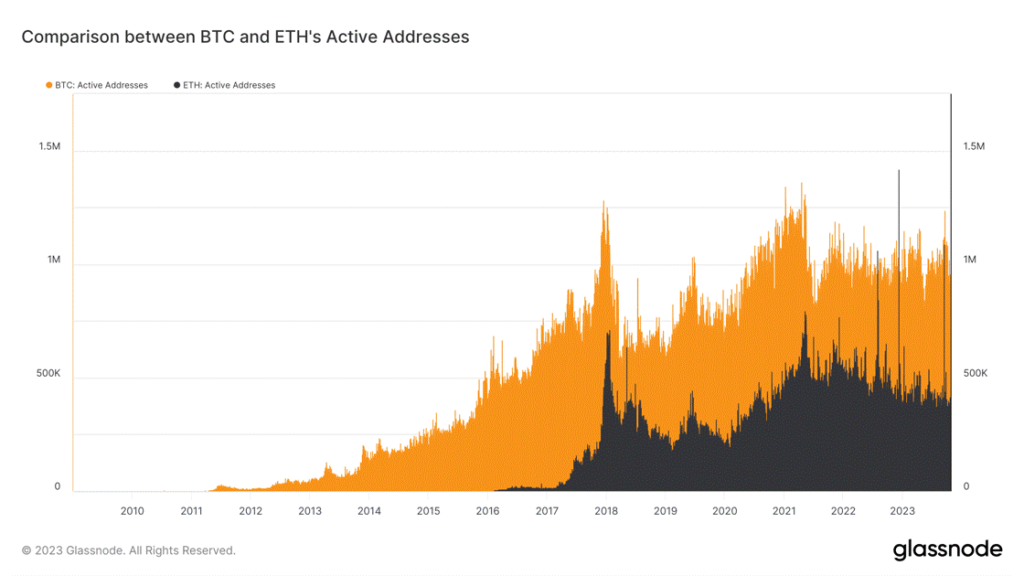
Source: Glassnode
• Binance Enters Data Storage Space
Binance’s venture into the decentralized storage space commenced last week with the launch of BNB Greenfield mainnet, focused on programmability, speed, and data control. BNB Greenfield aims to facilitate the decentralized data economy by simplifying the process of storing and managing data access, as well as linking data ownership with the massive DeFi context of the BNB Smart Chain (BSC). It enables Ethereum-compatible addresses to create and manage data and token assets seamlessly. It natively links data permissions and management logic onto BSC as exchangeable assets and smart contract programs, in turn providing developers with a more efficient and flexible way of managing their data and permissions. It provides similar API primitives and performance as popular existing Web 2 cloud storage systems.
With that said, BNB Greenfield not only competes with Web 2 counterparts like Amazon S3 and Google Cloud but with decentralized file storage applications like Arweave and Filecoin. In our latest State of Crypto, we delve deeper into the use case of data storage and how decentralized data storage blockchains have the potential to disrupt this space on the back of its permanent nature and the staggering cost discrepancies, which pour into the favor of decentralized data storage providers.
Figure 5: Cost of Decentralized vs. Centralized Storage in 2023
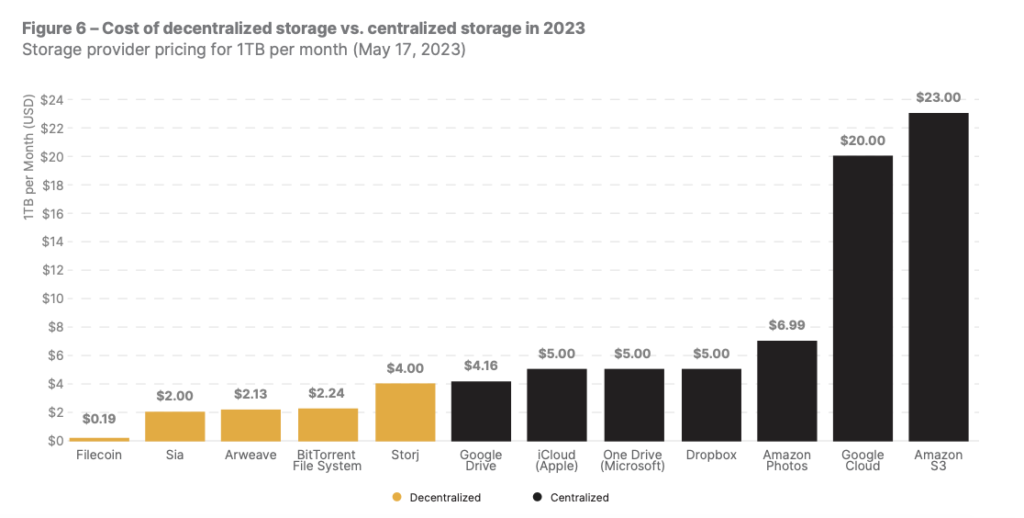
Source: Coingecko, from State of Crypto issue 10
• Are Uniswap’s New Fees a Double-Edged Sword?
Uniswap Labs will charge 0.15% fee for swaps executed on Uniswap’s interface and wallet specifically for these pairs: ETH, USDC, WETH, USDT, DAI, WBTC, agEUR, GUSD, LUSD, EUROC, XSGD, while excluding inter-stablecoin trades. The new swap fees are being imposed on traders to fund ongoing development and research of the largest decentralized exchange by assets under management. Revenue from Liquidity Providers (LPs) will remain untouched since they are essential for the liquidity of Uniswap. However, the fee accrual does not benefit holders of UNI, which remains to be a low utility governance token. From October 17 to 24, Uniswap Labs has earned over $350K. However, we anticipate exchange aggregators to increase their market share moving forward as they don’t incur Uniswap’s front-end fees and can allocate users the best prices from different venues with the lowest costs.
Figure 6: Cumulative Daily Revenue of Uniswap
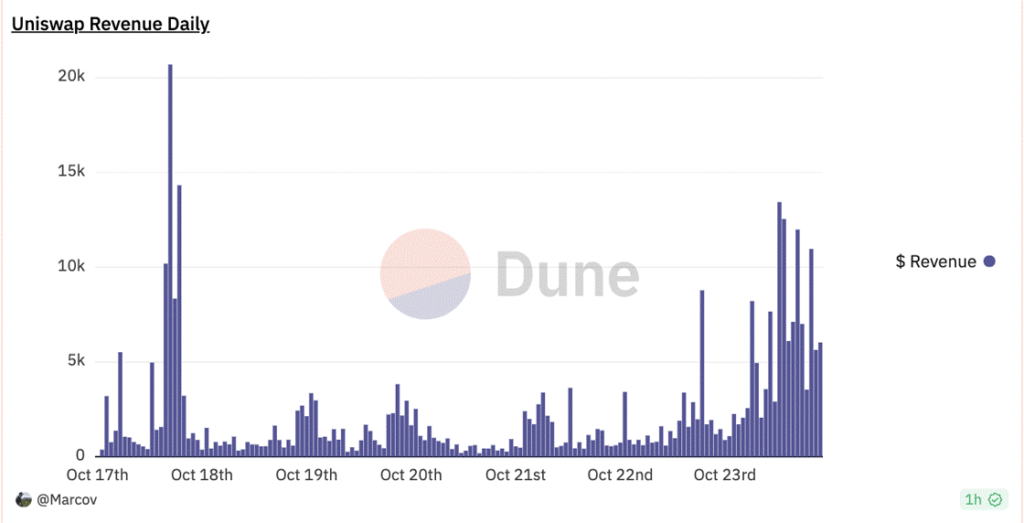
Source: Marcov on Dune Analytics
What You Should Pay Attention To
• Next Week’s FOMC Meeting: Can the Fed Impart Stability to the Bond Market?
The next Federal Open Market Committee (FOMC) meeting will be held on November 1, 2023. This is one of the key dates that investors should mark on their calendars due to the potential impact on global markets, including cryptoassets. The Fed held rates steady during their most recent meeting in September 2023, and Jerome Powell has hinted that the central bank may introduce one more 25 bps rate hike this year to moderate inflation to its 2% target. However, despite Powell’s signaling, the Fed must carefully balance the negative effects that increasing interest rates will have on global markets, particularly the banking sector, which already experienced turmoil in March. Figure 5 shows that the yield curve (10-year Treasury yield minus 2-year Treasury yield) is still inverted but close to going back to normal. Historically, this type of move has preceded global recessions, such as the 2008-9 Financial Crisis and the early 2000s recession after the dot-com bubble. How cryptoassets perform in such an environment remains to be seen, but recent history suggests that investors may turn to Bitcoin as a flight to quality due to its property of being a neutral, international, and censorship-resistant asset outside central banks’ control.
Figure 7: Yield Curve Inversion
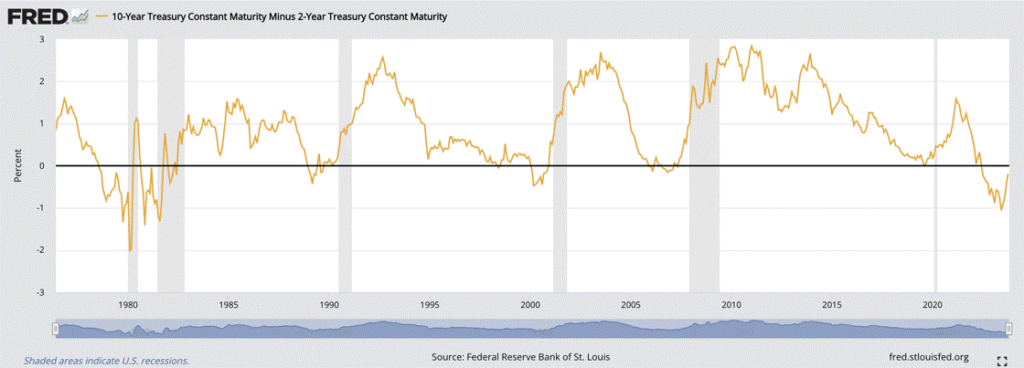
Source: Federal Reserve Bank of St. Louis
• Solana’s Breakpoint 2023 Conference is Next Week
The annual gathering of the Solana community will take place in Amsterdam from October 30 to November 3. Some of the planned programming includes keynotes from industry leaders like Circle, Google Cloud, Visa, and Greenpeace. Investors should be on the lookout for announcements regarding new innovations and products, as it’s the norm for this type of event. Earlier this year, the Ethereum Community Conference (EthCC) was filled with exciting announcements, including Lens Protocol V2, Gnosis Pay’s self-custodial Visa card, Solang, UniswapX, and Chainlink’s CCIP. Solana remains one of the most vibrant ecosystems outside of Ethereum with almost 1,000 monthly active developers, demonstrating that it has retained a loyal community despite the challenges experienced by the ecosystem in the past year, such as the FTX collapse. Crucially, Solana has also attracted the attention of non-crypto native players like Fintech giants Visa and Shopify.
• Our Very Own Researcher Karim Saber Will Speak at DuneCon 2023
On November 2, data enthusiasts will gather in Lisbon for DuneCon 2023, Dune Analytic’s annual community conference. Our researcher, Karim, will deliver an insightful keynote on behalf of 21.co, parent company of 21Shares. Through our real-time dashboards, 21.co has pushed the industry standard to help investors stay ahead of the curve with key fundamental and momentum on-chain metrics related to Bitcoin, Ethereum, and the broader crypto ecosystem. For instance, we recently released seven dashboards to follow the evolution of the tokenization space across various assets, such as government securities, equities, and real estate. Although the conference will not be live-streamed, recordings may be available afterward.
Bookmarks
• Senior Research Associate Adrian Fritz was featured on Boerse Muenchen.
• Our Tokenization Report was featured on multiple media outlets, such as Laura Chin’s Unchained and Coindesk.
• Check out our webinar, where the Research Team introduced the State of Crypto, featuring a special guest.
• State of Crypto issue 10 is out! Discover how crypto is changing the world.
Next Week’s Calendar
This is what we’re monitoring for next week.
• October 25: Fed Chair Jerome Powell to deliver opening remarks at the Moynihan Lecture in Social Science and Public Policy, in Washington DC
• October 30: Optimism is set to unlock 2.74% of its current circulating supply

Research Newsletter
Each week the 21Shares Research team will publish our data-driven insights into the crypto asset world through this newsletter. Please direct any comments, questions, and words of feedback to research@21shares.com
Disclaimer
The information provided does not constitute a prospectus or other offering material and does not contain or constitute an offer to sell or a solicitation of any offer to buy securities in any jurisdiction. Some of the information published herein may contain forward-looking statements. Readers are cautioned that any such forward-looking statements are not guarantees of future performance and involve risks and uncertainties and that actual results may differ materially from those in the forward-looking statements as a result of various factors. The information contained herein may not be considered as economic, legal, tax or other advice and users are cautioned to base investment decisions or other decisions solely on the content hereof.
Du kanske gillar
-
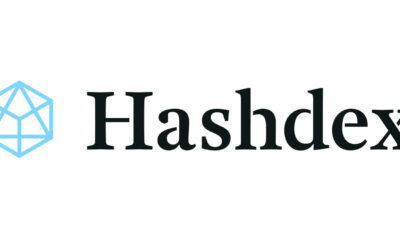

Spotlight on the tariff war
-
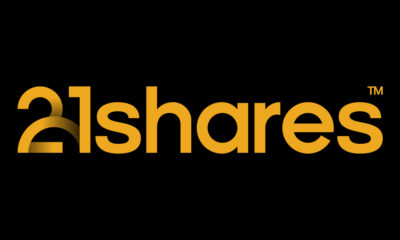

Michael Saylor’s bold Bitcoin bet and Strategy’s risk analysis
-


US regulatory shift provides a beacon for optimism
-
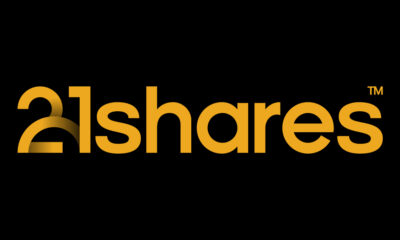

21Shares ringer i klockan på Nasdaq Stockholm
-
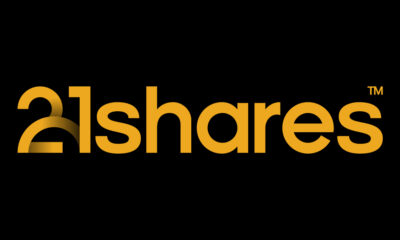

Crypto Market Risks & Opportunities: Insights on Bybit Hack, Bitcoin, and Institutional Adoption
-
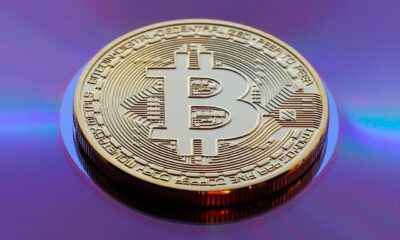

WisdomTree sänker avgiften för fysisk Bitcoin ETP till 0,15 %
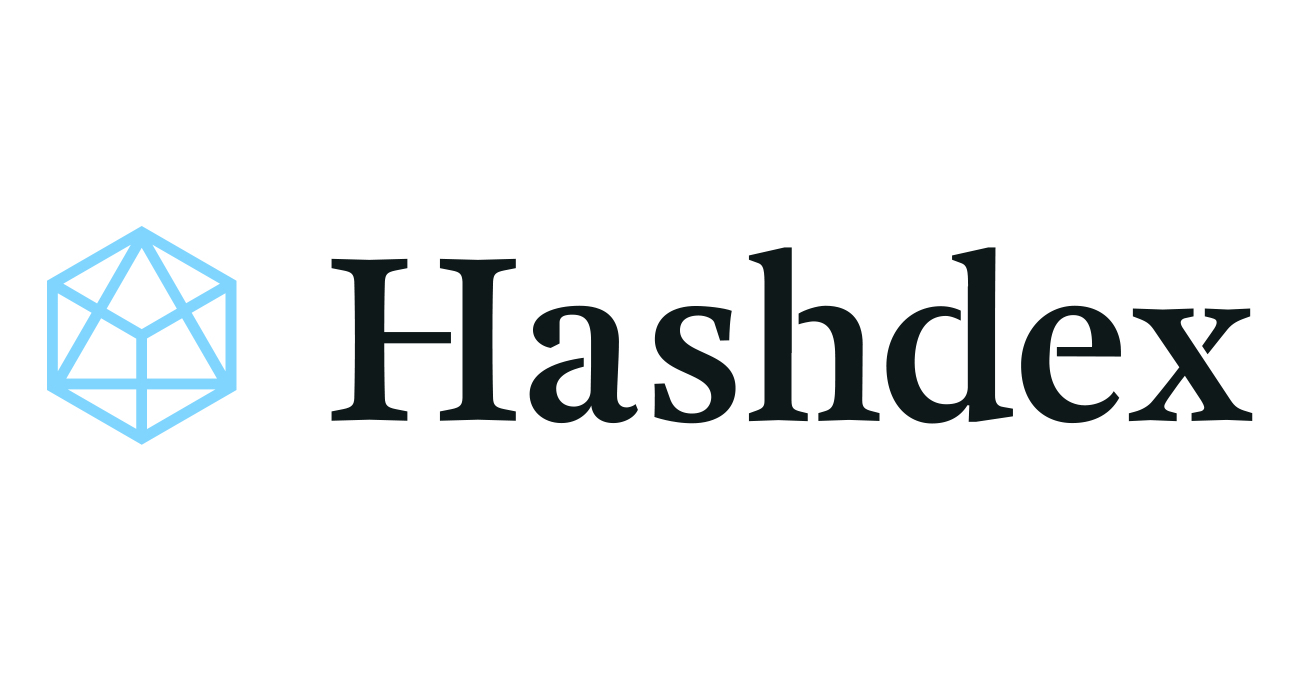
The impact of US tariffs continues to dominate market sentiment and risk assets, including crypto, struggled with this uncertainty throughout the month. The Nasdaq Crypto Index™ (NCI™) fell 4.46% in March as the S&P 500 and Nasdaq 100 dropped 5.63% and 7.61%, respectively.
Despite the macro uncertainty from Washington, US policymakers are continuing to embrace crypto in an unprecedented way, including launching a Bitcoin Strategic Reserve, Digital Asset Stockpile, and engaging in expansive work at the regulatory agencies and in Congress.
Our team spent the last week of the month in Washington, meeting with regulators to share our experiences and views on what’s most important for crypto investors in the US. In his latest Notes from the CIO, Samir Kerbage shares what he learned from these meetings and how investors should be thinking about the new regulatory regime in the US.
As always, we are greatly appreciative of your trust in us and are here to answer any questions you may have.
-Your Partners at Hashdex
Market Review
March was marked by the tariff dispute triggered by the Trump administration. Back-and-forth fiscal policies, threats, and retaliations dominated the month’s agenda. The uncertain macroeconomic environment put investors into a defensive stance and negatively impacted crypto assets. The Nasdaq Crypto Index™ (NCI™) closed the month down -4.46% after a period of high volatility. Major market indices, the S&P 500 and Nasdaq-100, also recorded steep declines of -5.63% and -7.61%, respectively. These concurrent drawdowns across equities and crypto underscored March’s broad market caution, as trade war uncertainty prompted investors to flee risk assets.
During times of uncertainty, it is common to observe increased correlation among different classes of risk assets. This pattern played out in March: the 6-month rolling correlation of monthly returns between the NCI™ and the Nasdaq-100 surged to roughly 0.91 (see chart below), its highest level since 2021, indicating that crypto assets were moving almost in lockstep with tech stocks. This spike in correlation confirms that crypto was behaving like a high-beta extension of the tech sector—an amplified version of the Nasdaq-100. The lack of clarity in the global landscape leads investors to reduce their risk exposure and seek protection, a movement known in financial markets as “risk-off” allocation.
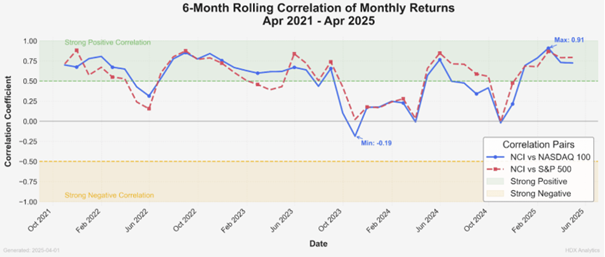
6-Month Rolling Correlation of Monthly Returns between the Nasdaq Crypto Index and Nasdaq-100 (Apr 2021–Apr 2025).
The chart illustrates how this correlation has been increasing since the American elections in November 2024 and spiked to approximately 0.91 in the most recent period—a multi-year high. This visual evidence reinforces the view that crypto assets have been moving closely in tandem with tech stocks, effectively acting as a high-beta version of the Nasdaq-100 during the March risk-off phase.
Following this trend, risk reduction was evident within the crypto asset class. Among the NCI’s constituents, Bitcoin (BTC) posted a decline of -1.93%, withstanding the downturn far better than other constituents such as Ether (ETH, -17.4%) and Litecoin (LTC, -34.6%). BTC’s relatively mild drop in this sell-off aligns with the idea that it increasingly trades like a high-beta proxy for large-cap tech. It still declined, but less severely, whereas smaller-cap crypto assets behaved more like speculative growth stocks and suffered outsized losses. The only exception to the negative results was Cardano (ADA), which surprised with a positive return of 3.88% despite no significant protocol developments during the month.
Thematic indices also faced a challenging environment. As highlighted in previous letters, smaller capitalization assets tend to suffer more during periods of market stress, mirroring how speculative small-cap stocks are hit hardest in equity sell-offs. The biggest negative highlight was the Digital Culture Index, which dropped -17.45%, followed by the Decentralized Finance (DeFi) and Smart Contract Platform (Web3) indices, which fell -16.73% and -12.07%, respectively. The Vinter Hashdex Risk Parity Momentum Index recorded a negative result of -8.26% but outperformed the three other thematic indices, benefiting from its high allocation in BTC and TRX (which gained 4.68%). The heavy weighting in BTC – the more resilient large-cap crypto – helped cushion this index, underscoring the relevance of the momentum factor in a well-diversified strategy during times of market stress.
The market remains on the lookout for the outcome of the fiscal policy discussions, hoping for a reduction in uncertainties and an end to the tariff war. That would likely mark the moment when investors regain their appetite for risk assets, including crypto assets. The U.S. government has also signaled interest in advancing the crypto agenda, a development that could drive the asset class to a new level of adoption. We remain confident in our positive outlook for the rest of the year and the long term.
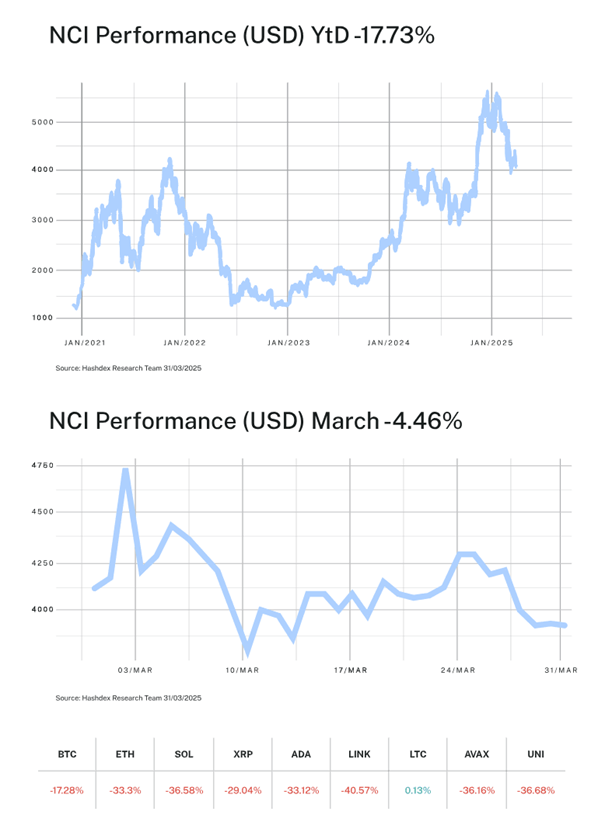
Top Stories
US creates Bitcoin Strategic Reserve and Digital Asset Stockpile
The Bitcoin Reserve will be capitalized with BTC owned by the Department of Treasury, which could further increase via new budget-neutral acquisitions. The stockpile will also include assets owned by the Treasury. This marks a major milestone, with the US government starting to integrate major crypto assets and continues the new administration’s work to lead the global crypto economy.
Stablecoins surpass $230 billion in market value
The total stablecoins market capitalization surpassed $230 billion amid institutional demand for dollar-backed digital assets. This showcases one of the most successful applications for crypto technology enhancing traditional financial payments. It could also pave the way for new use cases that require a strong and reliable global payment system.
FDIC eases banks’ ability to engage in crypto activities
The FDIC has rescinded previous guidelines which prevented financial institutions from engaging with crypto activities without prior sign-off. By removing bureaucratic hurdles, banks may more readily over crypto-related services, potentially leading to broader adoption and integration of digital assets into the financial system.
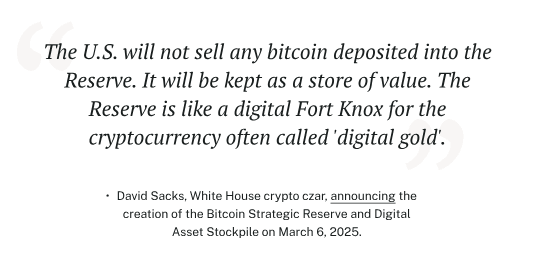

Nyheter
BSE8 ETF ger exponering mot företagsobligationer med förfall under 2028
Publicerad
10 timmar sedanden
5 april, 2025
Invesco BulletShares 2028 EUR Corporate Bond UCITS ETF EUR Acc (BSE8 ETF) med ISIN IE00079EUF59, försöker följa Bloomberg 2028 Maturity EUR Corporate Bond Screened-index. Bloomberg 2028 Maturity EUR Corporate Bond Screened Index följer företagsobligationer denominerade i EUR. Indexet speglar inte ett konstant löptidsintervall (som är fallet med de flesta andra obligationsindex). Istället ingår endast obligationer som förfaller under det angivna året (här: 2028) i indexet. Indexet består av ESG (environmental, social and governance) screenade företagsobligationer. Betyg: Investment Grade. Löptid: december 2028 (Denna ETF kommer att stängas efteråt).
Den börshandlade fondens TER (total cost ratio) uppgår till 0,10 % p.a. Invesco BulletShares 2028 EUR Corporate Bond UCITS ETF EUR Acc är den billigaste och största ETF som följer Bloomberg 2028 Maturity EUR Corporate Bond Screened index. ETFen replikerar det underliggande indexets prestanda genom samplingsteknik (köper ett urval av de mest relevanta indexbeståndsdelarna). Ränteintäkterna (kupongerna) i ETFen ackumuleras och återinvesteras.
Invesco BulletShares 2028 EUR Corporate Bond UCITS ETF EUR Acc är en mycket liten ETF med tillgångar på 6 miljoner euro under förvaltning. Denna ETF lanserades den 18 juni 2024 och har sin hemvist i Irland.
Produktbeskrivning
Invesco BulletShares 2028 EUR Corporate Bond UCITS ETF Acc syftar till att tillhandahålla den totala avkastningen för Bloomberg 2028 Maturity EUR Corporate Bond Screened Index (”Referensindexet”), minus avgifternas inverkan. Fonden har en fast löptid och kommer att upphöra på Förfallodagen.
Referensindexet är utformat för att återspegla resultatet för EUR-denominerade, investeringsklassade, fast ränta, skattepliktiga skuldebrev emitterade av företagsemittenter. För att vara kvalificerade för inkludering måste företagsvärdepapper ha minst 300 miljoner euro i nominellt utestående belopp och en effektiv löptid på eller mellan 1 januari 2028 och 31 december 2028.
Värdepapper är uteslutna om emittenter: 1) är inblandade i kontroversiella vapen, handeldvapen, militära kontrakt, oljesand, termiskt kol eller tobak; 2) inte har en kontroversnivå enligt definitionen av Sustainalytics eller har en Sustainalytics-kontroversnivå högre än 4; 3) anses inte följa principerna i FN:s Global Compact; eller 4) kommer från tillväxtmarknader.
Portföljförvaltarna strävar efter att uppnå fondens mål genom att tillämpa en urvalsstrategi, som inkluderar användning av kvantitativ analys, för att välja en andel av värdepapperen från referensindexet som representerar hela indexets egenskaper, med hjälp av faktorer som index- vägd genomsnittlig varaktighet, industrisektorer, landvikter och kreditkvalitet. När en företagsobligation som innehas av fonden når förfallodag kommer kontanterna som fonden tar emot att användas för att investera i kortfristiga EUR-denominerade skulder.
ETFen förvaltas passivt.
En investering i denna fond är ett förvärv av andelar i en passivt förvaltad indexföljande fond snarare än i de underliggande tillgångarna som ägs av fonden.
”Förfallodag”: den andra onsdagen i december 2026 eller sådant annat datum som bestäms av styrelseledamöterna och meddelas aktieägarna.
Handla BSE8 ETF
Invesco BulletShares 2028 EUR Corporate Bond UCITS ETF EUR Acc (BSE8 ETF) är en europeisk börshandlad fond. Denna fond handlas på Deutsche Boerse Xetra.
Det betyder att det går att handla andelar i denna ETF genom de flesta svenska banker och Internetmäklare, till exempel DEGIRO, Nordnet, Aktieinvest och Avanza.
Börsnoteringar
| Börs | Valuta | Kortnamn |
| XETRA | EUR | BSE8 |
Största innehav
| Namn | CUSIP | ISIN | Kupongränta | Vikt % |
| Volkswagen Leasing GmbH 3.875% 11/10/28 | D9T70CNQ3 | XS2745725155 | 3,875 | 2,19% |
| Swedbank AB 4.25% 11/07/28 | W94240FJ7 | XS2572496623 | 4,250 | 1,63% |
| ABN AMRO Bank NV 4.375% 20/10/28 | N0R37XLP3 | XS2613658710 | 4,375 | 1,62% |
| Carlsberg Breweries AS 4% 05/10/28 | K3662HDY6 | XS2696046460 | 4,000 | 1,60% |
| RCI Banque SA 4.875% 14/06/28 | F7S48DSE5 | FR001400IEQ0 | 4,875 | 1,59% |
| Booking Holdings Inc 3.625% 12/11/28 | — | XS2621007231 | 3,625 | 1,59% |
| Banco Santander SA 3.875% 16/01/28 | E2R99DB46 | XS2575952697 | 3,875 | 1,58% |
| Nordea Bank Abp 4.125% 05/05/28 | X5S8VP8C3 | XS2618906585 | 4,125 | 1,58% |
| E.ON SE 3.5% 12/01/28 | D2T8J8CT1 | XS2574873266 | 3,500 | 1,57% |
| General Motors Financial Co Inc 3.9% 12/01/28 | U37047BA1 | XS2747270630 | 3,900 | 1,57% |
Innehav kan komma att förändras

Det senaste veckan var den värsta veckan för världens aktiemarknader sedan covid-lockdown-kollapsen i mars 2020. Det var dessutom den värsta vecka för amerikanska aktier sedan covid-lockdown-kollapsen i mars 2020.
Det amerikanska referensindexet NASDAQ gick tillsammans med i Russell 2000, ett amerikanskt aktiemarknadsindex för småbolag i björnmarknadens territorium när dessa båda index fallit med över 20 procent från sina toppnoteringar. Samtidigt föll amerikanska Dow Jones med 2 200 punkter under fredagen.
Den grupp av företag som kallas för Mag 7 och har drivit börsuppgången på den amerikanska aktiemarknaden, tappade 1,4 biljoner dollar i börsvärde under veckan – det mest någonsin.
Fredagen den 4 april såh den högsta volymsessionen i historien på den amerikanska aktiemarknaden mätt som det totala antalet omsatta aktier på alla börser.
Det amerikanska VIX-indexet, känt som ”fear and greed-indexet” såg sin största veckorörelse sedan februari 2020. Det var också den värsta veckan för USAskreditmarknader sedan covid-lockdown-krisen, till och med värre än under SVB-bankkrisen.
Oljepriset kraschade med 11 procent under veckan, det största fallet sedan mars 2023 (SVB-kris / tillväxtskräck). Samtidigt rapporterade guldpriset den andra nedgångsvecka i år. Fredagen kursfall var den värsta dagen sedan november 2024. Priset på koppar såg sitt största fall sedan Lehman-kraschen i oktober 2008. Kryptovalutan Bitcoin rapporterade små vinster under veckan.

Spotlight on the tariff war

BSE8 ETF ger exponering mot företagsobligationer med förfall under 2028

En vecka för historieböckerna…

VGCF ETF investerar i korta företagsobligationer denominerade i euro

CBUV ETF satsar på Metaverse

Fonder som ger exponering mot försvarsindustrin

WisdomTree lanserar europeisk försvarsfond.

Warren Buffetts råd om vad man ska göra när börsen kraschar

De bästa börshandlade fonderna för tyska utdelningsaktier

Trumps återkomst får europeiska aktier att rusa
Populära
-

 Nyheter2 veckor sedan
Nyheter2 veckor sedanFonder som ger exponering mot försvarsindustrin
-

 Nyheter4 veckor sedan
Nyheter4 veckor sedanWisdomTree lanserar europeisk försvarsfond.
-

 Nyheter2 veckor sedan
Nyheter2 veckor sedanWarren Buffetts råd om vad man ska göra när börsen kraschar
-

 Nyheter3 veckor sedan
Nyheter3 veckor sedanDe bästa börshandlade fonderna för tyska utdelningsaktier
-

 Nyheter4 veckor sedan
Nyheter4 veckor sedanTrumps återkomst får europeiska aktier att rusa
-

 Nyheter5 dagar sedan
Nyheter5 dagar sedanSvenskarna har en ny favorit-ETF
-

 Nyheter2 veckor sedan
Nyheter2 veckor sedanHANetf lanserar Europa-fokuserad försvars-ETF
-

 Nyheter2 veckor sedan
Nyheter2 veckor sedanEn av de mest nedladdade finansapparna i Sverige


